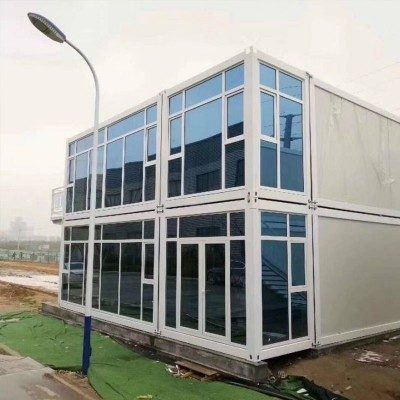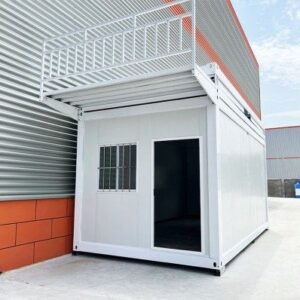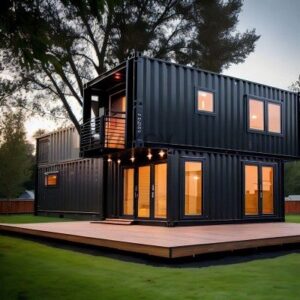Challenges of Insulating Container Houses
How to insulate container house with unique challenges mainly due to their metal walls and construction style. Unlike traditional homes built with wood or brick, shipping containers are made of steel, which has a high thermal conductivity. This means metal walls quickly transfer heat or cold, leading to significant heat loss or gain inside the container.
Unique Features Affecting Container Home Insulation
- Metal walls conduct heat fast, making it hard to maintain a stable indoor temperature.
- Containers have thin walls with limited natural insulation.
- The compact, boxy shape creates temperature fluctuations if insulation isn’t done properly.
- Metal surfaces can attract condensation, especially when the interior air is warm and the outside steel is cold.
Common Insulation Problems in Container Homes
- Condensation buildup is a big concern. Moisture collecting on metal surfaces can cause rust and structural damage.
- Poor insulation often leads to extreme temperature swings, making heating and cooling inefficient.
- The risk of mold growth increases if moisture is trapped between insulation and metal walls.
- Heat can be lost rapidly in the winter and gained in the summer due to the container’s thin steel shell.
Why Traditional Insulation Methods May Not Apply
- Standard insulation strategies for wood-frame homes may not fit container homes because of metal’s thermal properties.
- Typical insulation needs extra attention to vapor barriers and moisture control to prevent condensation.
- Some insulation types may cause issues if they trap moisture against steel, accelerating corrosion.
- Because of limited wall cavity space, bulky insulation can reduce interior space, so choosing compact yet effective insulation is critical.
Insulating a container home requires a tailored approach that carefully balances thermal protection with moisture prevention. Understanding these challenges is the first step toward choosing the right container home insulation materials and methods.
Best Insulation Materials for Container Houses
When it comes to container home insulation materials, choosing the right type is key because of the unique metal walls and high thermal conductivity of shipping containers. Here’s a breakdown of some of the most effective options, including their pros, cons, and cost factors.
Spray Foam Insulation for Container Homes
Benefits:
- Offers excellent air sealing and high R-values per inch (around R-6 to R-7)
- Expands to fill gaps, reducing condensation risks and moisture buildup
- Acts as a vapor barrier when closed-cell type is used
Disadvantages:
- Typically more expensive than other options (around $1 to $3 per sq.ft. installed)
- Requires professional installation for best results
- Can be tricky to retrofit in tight spaces
Rigid Foam Board Insulation Types and Effectiveness
Common rigid foam boards include XPS (extruded polystyrene), EPS (expanded polystyrene), and polyiso.
- XPS: Durable, moisture-resistant, R-value ~5 per inch
- EPS: More affordable but lower R-value (about 3.6 to 4.2)
- Polyiso: Highest R-value (6 to 6.5) but can lose effectiveness in cold climates
Rigid foam boards are great for both internal and external insulation and are easy to cut and install DIY-style.
Reflective Foil Insulation and Radiant Barriers
- Works by reflecting radiant heat, which helps in hot, sunny climates
- Thin and adds little thickness to walls
- Best when paired with an air gap, doesn’t work well alone in cold climates
- Inexpensive and good for preventing heat gain especially in summer
Mineral Wool and Fiberglass in Metal Containers
- Mineral wool is fire-resistant, water-repellent, and has good soundproofing qualities
- Fiberglass is affordable and widely available but can absorb moisture if not properly sealed, leading to mold issues in metal containers
- Both need a vapor barrier and tight sealing to prevent condensation problems
- Installation requires care with protective gear
Eco-Friendly and Natural Insulation Options
- Sheep wool: Naturally moisture-regulating, breathable, and sustainable
- Cellulose: Made from recycled paper, treated for fire and pest resistance
- These options offer better indoor air quality and are good for environmentally conscious builders but tend to have a lower R-value and may require more space
Comparison of Insulation Materials for Container Homes
| Material | R-Value per Inch | Cost per Sq.Ft. Installed | Lifespan | Pros | Cons |
|---|---|---|---|---|---|
| Spray Foam (Closed-cell) | 6 to 7 | $1 – $3 | 20+ years | Excellent air seal, moisture barrier | Expensive, requires pros |
| Rigid Foam Board XPS | 5 | $0.50 – $2 | 30+ years | Moisture resistant, durable | Moderate cost, rigid panels |
| Reflective Foil | N/A (reflective) | $0.20 – $0.50 | 15+ years | Thin, reduces heat gain | Only effective in hot climates |
| Mineral Wool | 3.7 – 4.2 | $0.40 – $1.50 | 30+ years | Fire resistant, soundproof | Needs vapor barrier |
| Fiberglass | 2.9 – 3.8 | $0.30 – $1.50 | 20+ years | Cheap, widely available | Moisture sensitive |
| Sheep Wool | 3 – 3.5 | $1 – $3 | 20+ years | Eco-friendly, moisture regulating | Lower R-value, costlier |
| Cellulose | 3.2 – 3.8 | $0.50 – $1.50 | 15-20 years | Sustainable, good soundproof | Requires fire treatment |
Choosing the right insulation depends on your climate, budget, and whether you prioritize durability, eco-friendliness, or ease of installation. For most U.S. container homeowners, spray foam and rigid foam boards remain top picks because they handle condensation well and offer solid insulation performance.
Step-by-Step Insulation Techniques for Container Homes
Insulating a container home properly means preparing thoroughly, choosing the right method, and taking steps to prevent moisture and condensation. Here’s a detailed guide on how to insulate your container home right.
Preparing Container Walls for Insulation
Before adding insulation, you need to prepare the metal walls carefully:
- Clean the walls thoroughly to remove rust, dirt, and grease. Use a wire brush or power washer.
- Inspect for any damages or holes and patch them up to prevent drafts.
- Install a vapor barrier—this is crucial because metal walls are prone to condensation. A quality vapor barrier reduces moisture buildup and protects insulation.
- Ensure the container is completely dry before proceeding.
Internal vs External Insulation Pros and Cons
Internal insulation is the most common for container homes since it’s easier to install and protects the structure from interior temperature shifts.
- Pros: Easier installation and better protection for insulation; allows for easier interior finishing.
- Cons: Slightly reduces interior space; potential for condensation if not done correctly.
External insulation involves adding insulation to the outside and then covering with cladding:
- Pros: Keeps the metal shell in a more stable temperature range, reducing condensation risk; maximizes interior space.
- Cons: More complex and expensive installation; requires weatherproof cladding for protection.
Installation for Spray Foam and Rigid Foam Board
Spray foam insulation is popular because it seals gaps and can fit uneven surfaces perfectly:
- Spray the foam evenly over the container walls.
- It expands and hardens, creating both insulation and an air barrier in one step.
- Make sure to do this in a well-ventilated space or hire a pro for safety.
Rigid foam board is another effective option:
- Cut the foam panels to fit the container’s dimensions.
- Attach firmly to walls with adhesive or mechanical fasteners.
- Seal seams with tape or foam to improve airtightness.
Preventing Condensation and Moisture Buildup
Condensation is one of the biggest enemies of container insulation. To control it:
- Use a high-quality vapor barrier on the warm side of the insulation (inside for cold climates).
- Ensure all gaps and seams are sealed tightly.
- Incorporate a drainage plane or moisture trap behind insulation if needed.
- Avoid installing insulation directly against metal with no barrier.
Ventilation Solutions Paired with Insulation
Proper ventilation is key to managing moisture and maintaining air quality:
- Install ventilation systems such as HVAC with humidity control or mechanical vents.
- Use vented soffits or ridge vents if applicable for fresh airflow.
- Consider heat recovery ventilators (HRVs) for energy-efficient air exchange.
Sealing Gaps and Improving Airtightness
To maximize your container home’s thermal efficiency:
- Seal all gaps around windows, doors, and seams with weatherproof caulk or spray foam.
- Pay special attention to wiring and plumbing penetrations.
- Use foam gaskets or door seals to reduce air leaks.
- Insulate and seal entry points to prevent drafts and heat loss.
Cost Breakdown and Budgeting Tips for Insulating Your Container Home
When planning container home insulation, understanding the costs involved and how to budget effectively is key. The price can vary widely depending on the insulation type, installation method, and size of your container house.
Estimated Costs for Insulation Types and Labor
Here’s a rough cost estimate per insulation method used in container homes:
- Spray foam insulation: $1.50 to $3.00 per square foot
- Offers excellent air sealing and high R-value
- Usually requires professional installation to ensure safety and effectiveness
- Rigid foam board insulation: $0.75 to $2.50 per square foot
- Cost-effective and easy to install for DIYers
- Varies depending on thickness and type (XPS, EPS, or polyiso)
- Reflective foil insulation and radiant barriers: $0.50 to $1.50 per square foot
- Best as supplementary layers, particularly for hot climates
- Mineral wool or fiberglass: $0.50 to $1.50 per square foot
- Affordable but can be tricky in metal containers due to moisture concerns
- Eco-friendly options (sheep wool, cellulose): $1.00 to $3.00 per square foot
- Natural and sustainable, but can cost more upfront
Labor costs vary based on region and project complexity, generally ranging from $35 to $75 per hour for professional installers. For spray foam, professional labor is often necessary, adding to the overall price.

Long-Term Savings and Energy Efficiency
Investing in proper insulation results in significant energy savings over time. Well-insulated container homes maintain indoor temperatures better, cutting down on heating and cooling costs. This is especially important given metal container walls’ tendency to conduct heat and cold rapidly.
- Proper insulation can reduce your energy bills by 20–40% yearly.
- Quality insulation also minimizes condensation and mold risk, potentially saving on costly repairs later.
- Energy-efficient homes tend to have better resale value and comfort year-round.
DIY Versus Professional Installation
Deciding between doing it yourself or hiring professionals depends on several factors:
DIY Installation
- Suitable for rigid board insulation or reflective foil if you have basic skills.
- Saves on labor costs but requires time, tools, and precise execution to prevent gaps and moisture issues.
- Vapor barriers and sealing details are critical to avoid condensation problems.
Professional Installation
- Recommended for spray foam insulation due to equipment, safety, and expertise.
- Ensures consistent coverage, airtight sealing, and maximizes R-value performance.
- Higher upfront costs but fewer risks of mistakes that can lead to costly fixes.
Budgeting Tips
- Assess your climate needs – Colder regions may require thicker or more efficient insulation, affecting costs.
- Plan for vapor barriers and ventilation – These are essential in container homes to keep moisture under control, sometimes overlooked in budgeting.
- Include finishing materials – Insulation often requires drywall or paneling, costing extra in materials and labor.
- Get multiple quotes – For professional work, always compare quotes and check references.
- Consider staged installation – If budget is tight, prioritize insulating walls and roof first, then add floor insulation later.
For more on building your container house including budgeting on overall costs, check out this guide on how much to build a container house.
Case Studies Insulating Container Homes with Spray Foam and Rigid Foams
Example 1 Small Container Home Spray Foam Insulation
A common method for insulating a small container home is using spray foam insulation. This approach works well because spray foam:
- Expands to fill gaps, sealing air leaks and improving airtightness
- Provides a high R-value per inch, boosting thermal insulation on thin metal walls
- Acts as a moisture barrier, reducing condensation risks on container steel panels
In this project, the spray foam was applied directly to cleaned container walls after installing a vapor barrier. The homeowner experienced:
- Better comfort levels year-round due to minimized heat loss and gain
- No visible condensation or mold issues even in high humidity
- Faster installation compared to using board insulation
Lessons learned: It’s critical to prepare surfaces thoroughly and control moisture inside to prevent trapped dampness. Also, ventilation still needs to be addressed despite spray foam’s sealing properties.
Example 2 Larger Container Home with Rigid Foam and Reflective Barriers
For a bigger container home design, rigid foam board insulation combined with reflective foil barriers was chosen. The layers worked together by:
- Rigid foam providing solid insulation with consistent R-values on container walls and ceiling
- Reflective foil reducing radiant heat gain, especially important in sunny or hotter climates
- Keeping insulation layers dry with proper vapor barriers installed on the warm side of the building
This setup lowered cooling costs significantly in summer and kept winters warmer without excessive heating bills. The homeowner reported long-term energy savings and an easy-to-maintain insulation system.
Common mistakes to avoid:
- Skipping the vapor barrier or installing it incorrectly can cause moisture buildup and damage insulation
- Not sealing edges and gaps tightly around foam boards, which can drop insulation efficiency
- Overlooking ventilation needs, which leads to condensation despite insulation layers
Both cases demonstrate that selecting the right insulation materials and following installation best practices is key for effective container house thermal insulation. Whether using spray foam or rigid foam with radiant barriers, addressing condensation, sealing air leaks, and ensuring proper ventilation set up a comfortable, energy-efficient container home.
Maintenance and Troubleshooting Container Home Insulation
Keeping your container house insulation in good shape is key to comfort and energy savings. Metal walls can be tricky because moisture and temperature swings can cause problems over time. Here’s how to spot issues early and maintain your insulation’s performance.
Signs of Insulation Failure and Moisture Issues
Watch out for these common red flags that your container home insulation might be failing:
- Cold or hot spots inside your container, indicating heat loss or gain
- Visible condensation or water droplets on walls or ceiling
- Musty odors or signs of mold, which point to trapped moisture
- Peeling or damaged wall finishes, suggesting moisture damage inside the insulation layer
- Increased energy bills without other explanation
Catch these signs early to avoid bigger problems.
Tips to Maintain Insulation Performance
To keep your shipping container insulated properly over time, consider these maintenance steps:
- Regularly inspect walls and ceilings for condensation or damage
- Maintain proper ventilation to reduce humidity inside the container
- Check and repair vapor barriers promptly to prevent moisture intrusion
- Seal any cracks or gaps that develop to keep air tightness intact
- Clean or replace filters in HVAC systems paired with your insulation
- Avoid puncturing or damaging insulation when running wires or pipes
Good upkeep extends the life of your insulation and stops mold or corrosion issues.
When to Call a Professional
Some problems need expert help even if you’re handy:
- Persistent moisture buildup despite ventilation fixes
- Extensive mold growth inside walls or floors
- Noticeable structural rust or corrosion linked to insulation failure
- Difficulty identifying the source of drafts or heat loss
A professional can inspect, diagnose, and recommend repair or insulation replacement options. Regular professional inspections every few years can catch hidden issues early before they turn costly.
Proper maintenance and timely troubleshooting keep your container home insulated well, comfortable, and energy efficient for years to come.
FAQs About How to Insulate Container House Effectively
How Thick Should Insulation Be for a Container House
The thickness depends on your climate and the insulation material’s R-value. For most U.S. climates, a minimum of 2 to 3 inches of spray foam or rigid foam board insulation provides good thermal protection. In colder regions, you might need 4 to 6 inches to reduce heat loss effectively. Remember, metal walls conduct heat fast, so extra thickness helps maintain comfortable indoor temperatures and lowers energy bills.
Can I Insulate Container Homes Myself
Yes, DIY insulation is possible, especially with materials like rigid foam boards or reflective foil insulation that are easier to install. Spray foam insulation usually requires professional equipment and expertise for best results. If you’re comfortable with basic construction and sealing gaps tightly, you can handle much of the insulation yourself, saving on labor costs. Just be sure to follow proper vapor barrier and ventilation guidelines to prevent moisture problems.
Is External or Internal Insulation Better for Container Houses
Both have pros and cons:
- Internal insulation is easier for DIY and protects the container’s structure but reduces interior space and requires careful moisture control.
- External insulation keeps the steel warmer, reducing condensation risk and preserving interior space but adds cost and complexity since it involves modifying the container’s outer shell or adding cladding.
For many homeowners, internal insulation paired with a good vapor barrier and ventilation strikes the best balance.
How to Insulate Container Homes in Different Climates
- Hot climates: Use reflective foil barriers combined with spray foam or rigid foam boards to reflect radiant heat and keep interiors cooler. Increase ventilation to avoid heat buildup.
- Cold climates: Thicker spray foam or mineral wool insulation is ideal to prevent heat loss and minimize condensation risk. Seal gaps tightly and add vapor barriers inside to keep moisture out.
- Humid climates: Focus on moisture control using vapor barriers, dehumidifiers, and proper ventilation. Spray foam or closed-cell insulation helps block moisture better than fiberglass in these conditions.
Best Insulation for Soundproofing Container Homes
Metal containers are noisy, so soundproofing is key. The best options:
- Mineral wool (rock wool) is excellent at absorbing sound and handling moisture.
- Spray foam offers decent sound deadening plus thermal insulation.
- Adding reflective insulation doesn’t help much with sound but can boost thermal comfort.
- Combine insulation with acoustic panels or drywall with soundproofing features for quieter living spaces



